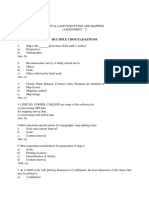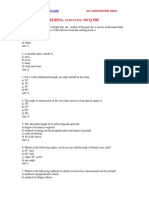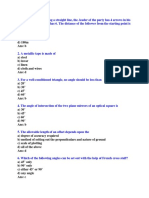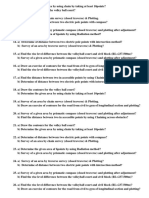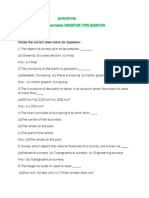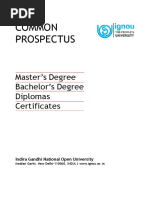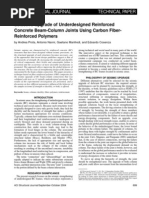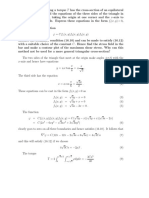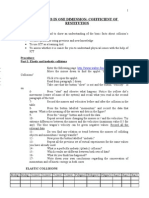MCQ On Surveying
MCQ On Surveying
Uploaded by
Shashikant GaurCopyright:
Available Formats
MCQ On Surveying
MCQ On Surveying
Uploaded by
Shashikant GaurOriginal Title
Copyright
Available Formats
Share this document
Did you find this document useful?
Is this content inappropriate?
Copyright:
Available Formats
MCQ On Surveying
MCQ On Surveying
Uploaded by
Shashikant GaurCopyright:
Available Formats
Civil Engineering - Surveying Multiple Choice Questions and Answers
1. A metallic tape is made of
d) all involve equal measurement on the ground Ans: a 5. The correction for sag is a) always additive b) always subtractive c) always zero d) sometimes additive and sometimes subtractive Ans: b 6. Cross staff is an instrument used for
a) steel b) invar c) linen d) cloth and wires Ans: d 2. For a well-conditioned triangle, no
angle should be less than a) 20 b) 30 c) 45 d) 60 Ans: b 3. The angle of intersection of the two
a) measuring approximate horizontal angles b) setting out right angles c) measuring bearings of the lines d) none of the above Ans: b 7. Normal tension is that pull which a) is used at the time of standardizing the tape b) neutralizes the effect due to pull and sag c) makes the correction due to sag equal to zero d) makes the correction due to pull equal to zero Ans: b 8. Which of the following is not used in
plane mirrors of an optical square is a) 30 b) 45 c) 60 d) 90 Ans: b 4. Which of the following methods of offsets involves less measurement on the ground? a) method of perpendicular offsets b) method of oblique offsets c) method of ties
measuring perpendicular offsets ?
a) line ranger b) steel tape c) optical square d) cross staff Ans: a 9. If the length of a chain is found to be
handle d) inside of one handle to inside of other handle Ans: b 12. Select the incorrect statement.
a) The true meridians at different places are parallel to each other. b) The true meridian at any place is not variable. c) The true meridians converge to a point in northern and southern hemispheres. d) The maps prepared by national survey departments of any country are based on true meridians. Ans: a
short on testing, it can be adjusted by a) straightening the links b) removing one or more small circular rings c) closing the joints of the rings if opened out d) all of the above Ans: a
10.
The maximum tolerance in a 20 m
13. In the prismatic compass a) the magnetic needle moves with the box b) the line of the sight does not move with the box c) the magnetic needle and graduated circle do not move with the box d) the graduated circle is fixed to the box and the magnetic needle always remains in the N-S direction Ans: c 14. For a line AB
chain is a) 2 mm b) 3 mm c) 5 mm d) 8 mm Ans: c 11. The length of a chain is measured from
a) centre of one handle to centre of other handle b) outside of one handle to outside of other handle c) outside of one handle to inside of other
a) the forebearing of AB and back bearing of AB differ by 180
b) the forebearing of AB and back bearing of BA differ by 180 c) both (a) and (b) are correct. d) none is correct Ans: a 15.. Local attraction in compass surveying
line c) both give QB of a line d) both give WCB of a line Ans: a 18. The horizontal angle between the true
meridian and magnetic meridian at a place is called a) azimuth b) declination c) local attraction d) magnetic bearing Ans: b
may exist due to a) incorrect levelling of the magnetic needle b) loss of magnetism of the needle c) friction of the needle at the pivot d) presence of magnetic substances near the instrument Ans: d 16. In the quadrantal bearing system, a
19.
A negative declination shows that the
magnetic meridian is to the' a) eastern side of the true meridian b) western side of the true meridian c) southern side of the true meridian d) none of the above Ans: b 20. The graduations in prismatic compass
whole circle bearing of 293 30' can be expressed as a) W2330'N b) N6630'W c) S11330'N d) N2330'W Ans: b 17. The prismatic compass and surveyor's
i) are inverted ii) are upright iii) run clockwise having 0 at south iv) run clockwise having 0 at north The correct answer is a) (i) and (iii) b) (i) and (iv)
compass a) give whole circle bearing (WCB) of a
line and quadrantal bearing (QB) of a line respectively b) both give QB of a line and WCB of a
c) (ii) and (iii) d) (ii) and (iv) Ans: a 21. Theodolite is an instrument used for
24. If the lower clamp screw is tightened and upper clamp screw is loosened, the theodolite may be rotated a) on its outer spindle with a relative motion between the vernier and graduated scale of lower plate b) on its outer spindle without a relative motion between the vernier and gra-duated scale of lower plate c) on its inner spindle with a relative motion between the vernier and the graduated scale of lower plate d) on its inner spindle without a relative motion between the vernier and the graduated scale of lower plate Ans: c 25. A telescope is said to be inverted if its
a) tightening the capstan-headed nuts of level tube b) measurement of horizontal angles only c) measurement of vertical angles only d) measurement of both horizontal and vertical angles Ans: d 22. The process of turning the telescope
about the vertical axis in horizontal plane is known as a) transiting b) reversing c) plunging d) swinging Ans: d 23. Which of the following is not the
a) vertical circle is to its right and the bubble of the telescope is down b) vertical circle is to its right and the bubble of the telescope is up c) vertical circle is to its left and the bubble of the telescope is down d) vertical circle is to its left and the bubble of the telescope is up Ans: a 26. The cross hairs in the surveying
function of levelling head ? a) to support the main part of the instrument b) to attach the theodolite to the tripod c) to provide a means for leveling the theodolite d) none of the above Ans: d
telescope are placed
a) midway between eye piece and objective lens b) much closer to the eye-piece than to the objective lens c) much closer to the objective lens than to the eye piece d) anywhere between eye-piece and objective lens Ans: b 27. For which of the following permanent adjustments of theodolite, the spire test is used ? a) adjustment of plate levels b) adjustment of line of sight c) adjustment of horizontal axis d) adjustment of altitude bubble and vertical index frame Ans: c 28. The adjustment of horizontal cross hair
horizontal angle measurement ? a) error due to eccentricity of verniers b) error due to displacement of station signals c) error due to wrong adjustment of line of collimation and trunnion axis d) error due to inaccurate graduation Ans: b 30. The error due to eccentricity of inner and outer axes can be eliminated by a) reading both verniers and taking the mean of the two b) taking both face observations and taking the mean of the two c) double sighting d) taking mean of several readings distributed over different portions of the graduated circle Ans: a 31. A'level line'is a
is required particularly when the instrument is used for a) leveling b) prolonging a straight line c) measurement of horizontal angles d) all of the above Ans: a 29. Which of the following errors is not
a) horizontal line b) line parallel to the mean spheriodal surface of earth c) line passing through the centre of cross hairs and the centre of eye piece d) line passing through the objective lens and the eye-piece of a dumpy or tilting level Ans: b
eliminated by the method of repetition of
32.
The rise and fall method of levelling
c) provides a check on the reduction of intermediate point levels d) quicker and less tedious for large number of intermediate sights Ans: c 36. If the staff is not held vertical at a levelling station, the reduced level calculated from the observation would be a) true R.L. b) more than true R.L. c) less than true R.L. d) none of the above Ans: c 37. Refraction correction
provides a complete check on a) backsight b) intermediate sight c) foresight d) all of the above Ans: d 33. If the R.L. of a B.M. is 100.00 m, the
back- sight is 1.215 m and the foresight is 1.870 m, the R.L. of the forward station is a) 99.345 m b) 100.345 m c) 100.655m d) 101.870m Ans: a 34. Height of instrument method of
a) completely eliminates curvature correction b) partially eliminates curvature correction c) adds to the curvature correction d) has no effect on curvature correction Ans: b 38. If the horizontal distance between the staff point and the point of observation is d, then the error due to curvature of earth is proportional to a) d b) 1/d c) d2 d) 1/d2
levelling is a) more accurate than rise and fall method b) less accurate than rise and fall method c) quicker and less tedious for large number of intermediate sights d) none of the above Ans: c 35. The rise and fall method
a) is less.accurate than height of instrument method b) is not suitable for levelling with tilting levels
Ans: c 39. Which of the following statements is incorrect ? a) Error due to refraction may not be completely eliminated by reciprocal levelling. b) Tilting levels are commonly used for precision work. c) The last reading of levelling is always a foresight. d) All of the above statements are incorrect. Ans: d 40. Dumpy level is most suitable when
Ans: a 42. Contour interval is
a) inversely proportional to the scale of the map b) directly proportional to the flatness of ground c) larger for accurate works d) larger if the time available is more Ans: a 43. An imaginary line lying throughout the
surface of ground and preserving a constant inclination to the horizontal is known as a) contour line b) horizontal equivalent c) contour interval d) contour gradient Ans: d 44. Select the correct statement.
a) the instrument is to be shifted frequently b) fly levelling is being done over long distance c) many readings are to be taken from a single setting of the instrument d) all of the above Ans: c 41. The difference of levels between two
a) A contour is not necessarily a closed curve. b) A contour represents a ridge line if the concave side of lower value contour lies towards the higher value contour. c) Two contours of different elevations do not cross each other except in case of an overhanging cliff. d) All of the above statements are correct. Ans: c
stations A and B is to be determined. For best results, the instrument station should be a) equidistant from A and B b) closer to the higher station c) closer to the lower station d) as far as possible from the line AB
45.
A series of closely spaced contour
The correct answer is a) only (i) b) (i)and(ii) c) (ii) and (iii) d) (i), (ii) and (iii) Ans: d 49. Which of the following methods of contouring is most suitable for a hilly terrain ? a) direct method b) square method c) cross-sections method d) tacheometric method Ans: d 50. Select the correct statement. a) Contour interval on any map is kept constant. b) Direct method of contouring is cheaper than indirect method. c) Inter-visibility of points on a contour
lines represents a a) steep slope b) gentle slope c) uniform slope d) plane surface Ans: a 46. Direct method of contouring is
a) a quick method b) adopted for large surveys only c) most accurate method d) suitable for hilly terrains Ans: c 47. In direct method of contouring, the
process of locating or identifying points lying on a contour is called a) ranging b) centring c) horizontal control d) vertical control Ans: d
map cannot be ascertained. d) Slope of a hill cannot be determined with the help of contours.
48.
In the cross-section method of indirect
Ans: a 51. Closed contours, with higher value
contouring, the spacing of cross-sections depends upon i) contour interval ii) scale of plan iii) characteristics of ground
inwards, represent a a) depression b) hillock c) plain surface
d) none of the above Ans: b 52. Contour interval is
b) urban areas c) hilly areas d) plains Ans: c 56. Detailed plotting is generally done by
a) the vertical distance between two consecutive contours b) the horizontal distance between two consecutive contours c) the vertical distance between two points on same contour d) the horizontal distance between two points on same contour Ans: a 53. Benchmark is established by
a) radiation b) traversing c) resection d) all of the above Ans: a 57. Three point problem can be solved by
a) Tracing paper method b) Bessels method c) Lehman's method
a) hypsometry b) barometric levelling c) spirit levelling d) trigonometrical levelling Ans: c 54. The type of surveying which requires
d) all of the above Ans: d 58. The process of determining the
locations of the instrument station by drawing re sectors from the locations of the known stations is called a) radiation b) intersection c) resection d) traversing Ans: c 59. The instrument used for accurate
least office work is a) tacheomefry b) trigonometrical levelling c) plane table surveying d) theodolite surveying Ans: c 55. Intersection method of detailed plotting is most suitable for a) forests
centering in plane table survey is a) spirit level
b) alidade c) plumbing fork d) trough compass Ans: c 60. Which of the following methods of
i) radiation ii) traversing iii) intersection iv) resection The correct answer is a) (i) and (ii) b) (iii) and (iv) c) (ii) and (iv) d) (i) and (iii) Ans: c 64. After fixing the plane table to the
plane table surveying is used to locate the position of an inaccessible point ? a) radiation b) intersection c) traversing d) resection Ans: b 61. The two point problem and three point
tripod, the main operations which are needed at each plane table station are i) levelling ii) orientation iii) centering The correct sequence of these operations is a) (i), (ii),.(iii) b) (i), (iii), (ii) c) (iii), (i), (ii) d) (ii), (Hi), (i) Ans: b 65. Which of the following methods of
problem are methods of a) resection b) orientation c) traversing d) resection and orientation Ans: d 62. The resection by two point problem as
compared to three point problem a) gives more accurate problem
b) takes less time c) requires more labour d) none of the above Ans: c 63. The methods used for locating the
theodolite traversing is suitable for locating the details which are far away from transit stations ? a) measuring angle and distance from one transit station
plane table stations are
b) measuring angles to the point from at least two stations c) measuring angle at one station and distance from other d) measuring distance from two points on traverse line Ans: b 101. The number of horizontal cross wires in a stadia diaphragm is a) one b) two c) three d) four Ans: c
66. For a tacheometer the additive and multi-plying constants are respectively a) 0 and 100 b) 100 and 0 c) 0 and 0 d) 100 and 100 Ans: a
You might also like
- Top 40 Surveying Interview Questions With Answers100% (7)Top 40 Surveying Interview Questions With Answers5 pages
- SURVEYING Multiple Choice Questions With Answers PDF91% (33)SURVEYING Multiple Choice Questions With Answers PDF31 pages
- 02.transportation Engineering Question (Qwa) PDF100% (2)02.transportation Engineering Question (Qwa) PDF18 pages
- Civil Questions and Answers - Surveying PDF100% (5)Civil Questions and Answers - Surveying PDF16 pages
- Civil Engineering-Surveying and Leveling 362 Important MCQ PDF100% (3)Civil Engineering-Surveying and Leveling 362 Important MCQ PDF70 pages
- CE6304 Surveying 1 Question Bank Download Here75% (4)CE6304 Surveying 1 Question Bank Download Here12 pages
- Wednesday, 3 October 2012: Civil Engineering - Surveying Multiple Choice Questions and Answers100% (1)Wednesday, 3 October 2012: Civil Engineering - Surveying Multiple Choice Questions and Answers17 pages
- 110 TOP MOST SURVEYING Interview Questions and Answers - Civil Engineering Objective Type Questions100% (1)110 TOP MOST SURVEYING Interview Questions and Answers - Civil Engineering Objective Type Questions18 pages
- Civil Engineering - Surveying Multiple Choice Questions and Answers - Preparation For Engineering64% (11)Civil Engineering - Surveying Multiple Choice Questions and Answers - Preparation For Engineering15 pages
- ACFrOgA5EauarD75jvFcyrabAHOdSMnkkfEGiwgbz6Mj1EJGo5gUwfGBNuAMXifSk5UlTdQZ3YtNYf iwu0XGmdHKaK2lfP p1QTfDUqSPVqjI0BvybAvvIL28eZ2aINo ratings yetACFrOgA5EauarD75jvFcyrabAHOdSMnkkfEGiwgbz6Mj1EJGo5gUwfGBNuAMXifSk5UlTdQZ3YtNYf iwu0XGmdHKaK2lfP p1QTfDUqSPVqjI0BvybAvvIL28eZ2aI22 pages
- MCQ Questions For Surveying With Solution For Engineering StudentsNo ratings yetMCQ Questions For Surveying With Solution For Engineering Students15 pages
- 2013 Cadastral Surveying - Test 1 (MEMO) PDF100% (3)2013 Cadastral Surveying - Test 1 (MEMO) PDF5 pages
- Global Positioning System Fill in The Blanks Unit I: Introduction100% (1)Global Positioning System Fill in The Blanks Unit I: Introduction15 pages
- Linear Measurements in Surveying Objective Questions100% (1)Linear Measurements in Surveying Objective Questions6 pages
- 250+ TOP MCQs On Geotechnical Engineering and Answers100% (3)250+ TOP MCQs On Geotechnical Engineering and Answers4 pages
- 300+ Top Surveying Lab Viva Questions and Answers: Loading..No ratings yet300+ Top Surveying Lab Viva Questions and Answers: Loading..4 pages
- Drawing and Surveying Multiple Choice Questions and AnswersNo ratings yetDrawing and Surveying Multiple Choice Questions and Answers12 pages
- Pad. DR.D Y Patil Institute of Engineering, Management & Research Akurdi Pune Department of Civil Engineering S. E. (Civil) Unit Test Examination-I Set A Sub: SurveyingNo ratings yetPad. DR.D Y Patil Institute of Engineering, Management & Research Akurdi Pune Department of Civil Engineering S. E. (Civil) Unit Test Examination-I Set A Sub: Surveying14 pages
- Municipal Committee Taraori: Tender Document FORNo ratings yetMunicipal Committee Taraori: Tender Document FOR18 pages
- Municipal Committee Safidon: Tender Document FORNo ratings yetMunicipal Committee Safidon: Tender Document FOR19 pages
- Government of Haryana: Dulb, Bays No. 11-14, Sector-4, PanchkulaNo ratings yetGovernment of Haryana: Dulb, Bays No. 11-14, Sector-4, Panchkula1 page
- Municipal Corporation, Panchkula HaryanaNo ratings yetMunicipal Corporation, Panchkula Haryana21 pages
- Office of Municipal Committee, Safidon: Lopn Lqhnksa Lopn GFJ K.KKNo ratings yetOffice of Municipal Committee, Safidon: Lopn Lqhnksa Lopn GFJ K.KK2 pages
- Office of Municipal Committee, GharaundaNo ratings yetOffice of Municipal Committee, Gharaunda6 pages
- Estimate For Construction of 2 Rooms Civil Work: Below Finish Floor LevelNo ratings yetEstimate For Construction of 2 Rooms Civil Work: Below Finish Floor Level13 pages
- Cold Room-3 18.500 X 16.32 Cold Room-1 18.500 X 16.32No ratings yetCold Room-3 18.500 X 16.32 Cold Room-1 18.500 X 16.321 page
- Civil Work: Description of Item Qty. Unit C.P. Amount Sr. No. Basic Rate Rate + C.PNo ratings yetCivil Work: Description of Item Qty. Unit C.P. Amount Sr. No. Basic Rate Rate + C.P50 pages
- Potential and Kinetic Energy Practice CpoNo ratings yetPotential and Kinetic Energy Practice Cpo6 pages
- Tribological Behaviour of Sic Particle-Reinforced Copper Matrix CompositesNo ratings yetTribological Behaviour of Sic Particle-Reinforced Copper Matrix Composites7 pages
- Mechanical Measurements and Metrology: Subject Code: 10ME32B Prepared By: Nikita Department: Aeronautical EngineeringNo ratings yetMechanical Measurements and Metrology: Subject Code: 10ME32B Prepared By: Nikita Department: Aeronautical Engineering24 pages
- Objective Chemistry for NEET and Other Medical Entrance Examinations Vol II K. Rama Rao 2024 scribd download100% (11)Objective Chemistry for NEET and Other Medical Entrance Examinations Vol II K. Rama Rao 2024 scribd download66 pages
- Radioactivity: Instructor: MR Toba Al-Kheir Islamic Girls' SeminaryNo ratings yetRadioactivity: Instructor: MR Toba Al-Kheir Islamic Girls' Seminary86 pages
- Yanajara-Parra 2024 J. Phys. Commun. 8 025004No ratings yetYanajara-Parra 2024 J. Phys. Commun. 8 02500410 pages
- Fundamentals of Physics Extended 10th Edition David HallidayNo ratings yetFundamentals of Physics Extended 10th Edition David Halliday84 pages
- CBSE - Magnetic Effects of Electric CurrentNo ratings yetCBSE - Magnetic Effects of Electric Current5 pages
- MANNING River Hydraulics and The ChannelNo ratings yetMANNING River Hydraulics and The Channel26 pages
- Complete Download Newtonian Mechanics for Undergraduates 1st Edition Vijay Tymms PDF All ChaptersNo ratings yetComplete Download Newtonian Mechanics for Undergraduates 1st Edition Vijay Tymms PDF All Chapters55 pages
- Design of Electrical Apparatus Solved ProblemsNo ratings yetDesign of Electrical Apparatus Solved Problems14 pages
- CBSE Previous Year Question Papers Class 12 PhysicsNo ratings yetCBSE Previous Year Question Papers Class 12 Physics168 pages
- SURVEYING Multiple Choice Questions With Answers PDFSURVEYING Multiple Choice Questions With Answers PDF
- Civil Engineering-Surveying and Leveling 362 Important MCQ PDFCivil Engineering-Surveying and Leveling 362 Important MCQ PDF
- Wednesday, 3 October 2012: Civil Engineering - Surveying Multiple Choice Questions and AnswersWednesday, 3 October 2012: Civil Engineering - Surveying Multiple Choice Questions and Answers
- 110 TOP MOST SURVEYING Interview Questions and Answers - Civil Engineering Objective Type Questions110 TOP MOST SURVEYING Interview Questions and Answers - Civil Engineering Objective Type Questions
- Civil Engineering - Surveying Multiple Choice Questions and Answers - Preparation For EngineeringCivil Engineering - Surveying Multiple Choice Questions and Answers - Preparation For Engineering
- ACFrOgA5EauarD75jvFcyrabAHOdSMnkkfEGiwgbz6Mj1EJGo5gUwfGBNuAMXifSk5UlTdQZ3YtNYf iwu0XGmdHKaK2lfP p1QTfDUqSPVqjI0BvybAvvIL28eZ2aIACFrOgA5EauarD75jvFcyrabAHOdSMnkkfEGiwgbz6Mj1EJGo5gUwfGBNuAMXifSk5UlTdQZ3YtNYf iwu0XGmdHKaK2lfP p1QTfDUqSPVqjI0BvybAvvIL28eZ2aI
- MCQ Questions For Surveying With Solution For Engineering StudentsMCQ Questions For Surveying With Solution For Engineering Students
- Global Positioning System Fill in The Blanks Unit I: IntroductionGlobal Positioning System Fill in The Blanks Unit I: Introduction
- Linear Measurements in Surveying Objective QuestionsLinear Measurements in Surveying Objective Questions
- 250+ TOP MCQs On Geotechnical Engineering and Answers250+ TOP MCQs On Geotechnical Engineering and Answers
- 300+ Top Surveying Lab Viva Questions and Answers: Loading..300+ Top Surveying Lab Viva Questions and Answers: Loading..
- Drawing and Surveying Multiple Choice Questions and AnswersDrawing and Surveying Multiple Choice Questions and Answers
- Pad. DR.D Y Patil Institute of Engineering, Management & Research Akurdi Pune Department of Civil Engineering S. E. (Civil) Unit Test Examination-I Set A Sub: SurveyingPad. DR.D Y Patil Institute of Engineering, Management & Research Akurdi Pune Department of Civil Engineering S. E. (Civil) Unit Test Examination-I Set A Sub: Surveying
- Government of Haryana: Dulb, Bays No. 11-14, Sector-4, PanchkulaGovernment of Haryana: Dulb, Bays No. 11-14, Sector-4, Panchkula
- Office of Municipal Committee, Safidon: Lopn Lqhnksa Lopn GFJ K.KKOffice of Municipal Committee, Safidon: Lopn Lqhnksa Lopn GFJ K.KK
- Estimate For Construction of 2 Rooms Civil Work: Below Finish Floor LevelEstimate For Construction of 2 Rooms Civil Work: Below Finish Floor Level
- Cold Room-3 18.500 X 16.32 Cold Room-1 18.500 X 16.32Cold Room-3 18.500 X 16.32 Cold Room-1 18.500 X 16.32
- Civil Work: Description of Item Qty. Unit C.P. Amount Sr. No. Basic Rate Rate + C.PCivil Work: Description of Item Qty. Unit C.P. Amount Sr. No. Basic Rate Rate + C.P
- Tribological Behaviour of Sic Particle-Reinforced Copper Matrix CompositesTribological Behaviour of Sic Particle-Reinforced Copper Matrix Composites
- Mechanical Measurements and Metrology: Subject Code: 10ME32B Prepared By: Nikita Department: Aeronautical EngineeringMechanical Measurements and Metrology: Subject Code: 10ME32B Prepared By: Nikita Department: Aeronautical Engineering
- Objective Chemistry for NEET and Other Medical Entrance Examinations Vol II K. Rama Rao 2024 scribd downloadObjective Chemistry for NEET and Other Medical Entrance Examinations Vol II K. Rama Rao 2024 scribd download
- Radioactivity: Instructor: MR Toba Al-Kheir Islamic Girls' SeminaryRadioactivity: Instructor: MR Toba Al-Kheir Islamic Girls' Seminary
- Fundamentals of Physics Extended 10th Edition David HallidayFundamentals of Physics Extended 10th Edition David Halliday
- Complete Download Newtonian Mechanics for Undergraduates 1st Edition Vijay Tymms PDF All ChaptersComplete Download Newtonian Mechanics for Undergraduates 1st Edition Vijay Tymms PDF All Chapters
- CBSE Previous Year Question Papers Class 12 PhysicsCBSE Previous Year Question Papers Class 12 Physics


